The history of local government in London, England can be broken down into a number of periods.
| From | Legislation | System |
|---|---|---|
| 1835 | Municipal Corporations Act 1835 | The small, ancient and self-governing City of London is unreformed by legislation covering the other major city corporations and does not expand into the growing metropolitan area surrounding it. The area that is currently Greater London is administered by parishes and hundreds in the counties of Middlesex, Essex, Kent, Surrey and Hertfordshire, with very little co-ordination between them.[1] Special areas such as the Liberty of Westminster are exempt from county administration. In other areas ad-hoc single-purpose boards are set up. Commentators consider it to be a system 'in chaos'.[1] |
| 1855 | Metropolis Management Act 1855 | The Metropolitan Board of Works is created to provide the infrastructure needed in the area now known as Inner London, its members are nominated by the vestries and boards.[2] |
| 1889 | Local Government Act 1888 | The County of London is created from the area of responsibility of the Metropolitan Board of Works.[3] A London County Council shares power with the boards and vestries. The City of London is outside of its scope. Croydon and West Ham (and later East Ham) become county boroughs outside the County of London but also outside the control of the newly formed Surrey and Essex county councils. |
| 1894 | Local Government Act 1894 | The rest of England, including the area around the County of London and the county boroughs (but not within it), is divided into urban districts and rural districts. In the Greater London area they become consolidated over the next 70 years into municipal boroughs and urban districts with no rural districts remaining. Many districts later become populous enough to apply for county boroughs status, but are rejected. A Royal Commission on the Amalgamation of the City and County of London attempts to facilitate the merger of the City and County of London, but fails. |
| 1900 | London Government Act 1899 | Metropolitan boroughs are created within the County of London and functions are shared with the London County Council. The vestries, boards and liberties in the area are abolished. |
| 1965 | London Government Act 1963 | An enlarged Greater London replaces the County of London, Middlesex County Council, the county boroughs and all local government districts within around a 12-mile radius. The mostly strategic Greater London Council shares power with the 32 London boroughs and the City of London.[4] |
| 1986 | Local Government Act 1985 | The Greater London Council is abolished and the London boroughs work as unitary authorities with strategic functions organised by joint boards and quangos.[5] A residual Inner London Education Authority remains for the inner area, but is abolished during a national reform of education. |
| 2000 | Greater London Authority Act 1999 | The regional Greater London Authority, consisting of the Mayor of London and the London Assembly assume a strategic function, sharing power with the London boroughs and the City of London.[6] |
Gallery
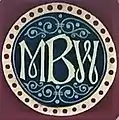 Logo of the Metropolitan Board of Works
Logo of the Metropolitan Board of Works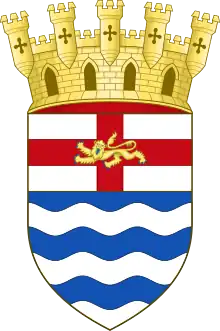
 Flag of the London County Council (1914-1965)
Flag of the London County Council (1914-1965)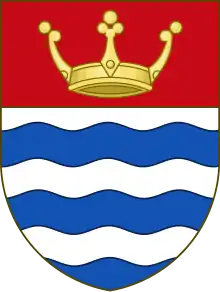 Coat of arms of Greater London Council
Coat of arms of Greater London Council Banner of the Greater London Council (1965-1986)
Banner of the Greater London Council (1965-1986) Flag of the Greater London Council (1965-1986)
Flag of the Greater London Council (1965-1986) Greater London Authority logo (2000-2001)
Greater London Authority logo (2000-2001) Flag of the Greater London Authority (2001-2020)
Flag of the Greater London Authority (2001-2020).png.webp) Flag of the Greater London Authority (2020-)
Flag of the Greater London Authority (2020-).png.webp) Greater London Authority logo (2001–present)
Greater London Authority logo (2001–present) Spring Gardens, home of the Metropolitan Board of Works
Spring Gardens, home of the Metropolitan Board of Works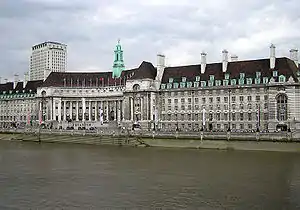 County Hall, former home of the London County Council and Greater London Council
County Hall, former home of the London County Council and Greater London Council Council chamber within County Hall
Council chamber within County Hall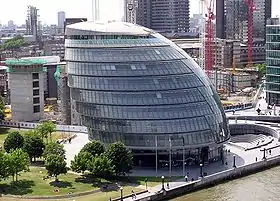 City Hall, London (Southwark), home of the Greater London Authority from 2002 to 2021
City Hall, London (Southwark), home of the Greater London Authority from 2002 to 2021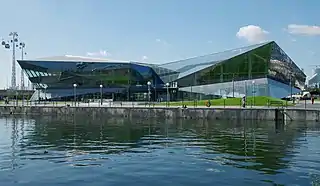 City Hall, London (Newham), home of the Greater London Authority from January 2022
City Hall, London (Newham), home of the Greater London Authority from January 2022 City of London (red) compared to Greater London
City of London (red) compared to Greater London County of London shown within England (in 1889)
County of London shown within England (in 1889)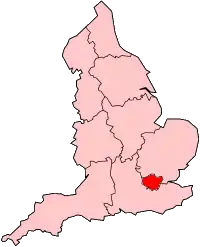 Greater London shown within England
Greater London shown within England County of London compared to Greater London
County of London compared to Greater London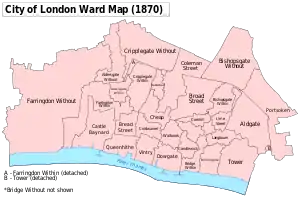 A map of the wards of the City as they were in the late 19th century.
A map of the wards of the City as they were in the late 19th century.
See also
References
- 1 2 Barlow, I., Metropolitan Government, (1991)
- ↑ Saint, A., Politics and the people of London: the London County Council (1889-1965), (1989)
- ↑ Thomson, D., England in the Nineteenth Century (1815-1914), (1978)
- ↑ Redcliffe-Maud & Wood, B., English Local Government Reformed, (1974)
- ↑ Kingdom, J., Local Government and Politics in Britain, (1991)
- ↑ Jones, B. et al., Politics UK, (2004)
Further reading
- Torrens, William McCullagh (1884). . London: Kegan Paul, Trench, and Co.
This article is issued from Wikipedia. The text is licensed under Creative Commons - Attribution - Sharealike. Additional terms may apply for the media files.